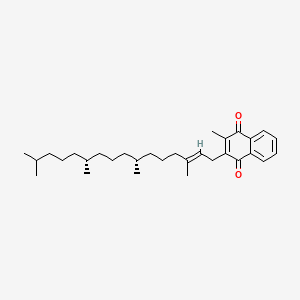| MeSH term | MeSH ID | Detail |
|---|---|---|
| Thromboembolism | D013923 | 6 associated lipids |
| Vitamin K Deficiency | D014813 | 5 associated lipids |
| Exanthema | D005076 | 11 associated lipids |
phylloquinone
Phylloquinone is a lipid of Prenol Lipids (PR) class. Phylloquinone is associated with abnormalities such as Vitamin K Deficiency, Malnutrition, Consumption-archaic term for TB, Osteoporosis and Hyperostosis, Diffuse Idiopathic Skeletal. The involved functions are known as Ingestion, Blood Circulation, Genetic Polymorphism, Intestinal Absorption and Process. Phylloquinone often locates in Blood, Body tissue, Hepatic, Membrane and Entire bony skeleton. The associated genes with phylloquinone are Vitamin K Epoxide Reductase Complex, Subunit 1, GGCX gene, CYP4F2 gene, Alleles and APOE gene. The related lipids are Micelles, 208-G, Fatty Acids, Total cholesterol and Sphingolipids. The related experimental models are Knock-out.
Cross Reference
Introduction
To understand associated biological information of phylloquinone, we collected biological information of abnormalities, associated pathways, cellular/molecular locations, biological functions, related genes/proteins, lipids and common seen animal/experimental models with organized paragraphs from literatures.
What diseases are associated with phylloquinone?
phylloquinone is suspected in Vitamin K Deficiency, Diabetes Mellitus, Non-Insulin-Dependent, Diabetes, vitamin depletion, Malnutrition, Osteoporosis and other diseases in descending order of the highest number of associated sentences.
Related references are mostly published in these journals:
| Disease | Cross reference | Weighted score | Related literature |
|---|
Possible diseases from mapped MeSH terms on references
We collected disease MeSH terms mapped to the references associated with phylloquinone
PubChem Associated disorders and diseases
What pathways are associated with phylloquinone
There are no associated biomedical information in the current reference collection.
PubChem Biomolecular Interactions and Pathways
Link to PubChem Biomolecular Interactions and PathwaysWhat cellular locations are associated with phylloquinone?
Visualization in cellular structure
Associated locations are in red color. Not associated locations are in black.
Related references are published most in these journals:
| Location | Cross reference | Weighted score | Related literatures |
|---|
What functions are associated with phylloquinone?
Related references are published most in these journals:
| Function | Cross reference | Weighted score | Related literatures |
|---|
What lipids are associated with phylloquinone?
Related references are published most in these journals:
| Lipid concept | Cross reference | Weighted score | Related literatures |
|---|
What genes are associated with phylloquinone?
Related references are published most in these journals:
| Gene | Cross reference | Weighted score | Related literatures |
|---|
What common seen animal models are associated with phylloquinone?
Knock-out
Knock-out are used in the study 'A dedicated thioesterase of the Hotdog-fold family is required for the biosynthesis of the naphthoquinone ring of vitamin K1.' (Widhalm JR et al., 2009) and Knock-out are used in the study 'Deficiency in phylloquinone (vitamin K1) methylation affects prenyl quinone distribution, photosystem I abundance, and anthocyanin accumulation in the Arabidopsis AtmenG mutant.' (Lohmann A et al., 2006).
Related references are published most in these journals:
| Model | Cross reference | Weighted score | Related literatures |
|---|
NCBI Entrez Crosslinks
All references with phylloquinone
Download all related citations| Authors | Title | Published | Journal | PubMed Link |
|---|---|---|---|---|
| Stork CM et al. | Elevated International Normalized Ratio associated with long-term azithromycin therapy in a child with cerebral palsy. | 2011 | Am J Health Syst Pharm | pmid:21593229 |
| Fusaro M et al. | Vitamin K, bone fractures, and vascular calcifications in chronic kidney disease: an important but poorly studied relationship. | 2011 | J. Endocrinol. Invest. | pmid:21088475 |
| Braga CB et al. | Serum vitamins in adult patients with short bowel syndrome receiving intermittent parenteral nutrition. | 2011 | JPEN J Parenter Enteral Nutr | pmid:21628608 |
| Lamb JJ et al. | Nutritional supplementation of hop rho iso-alpha acids, berberine, vitamin D₃, and vitamin K₠produces a favorable bone biomarker profile supporting healthy bone metabolism in postmenopausal women with metabolic syndrome. | 2011 | Nutr Res | pmid:21636012 |
| Carrié I et al. | Lifelong low-phylloquinone intake is associated with cognitive impairments in old rats. | 2011 | J. Nutr. | pmid:21653572 |
| Westhofen P et al. | Human vitamin K 2,3-epoxide reductase complex subunit 1-like 1 (VKORC1L1) mediates vitamin K-dependent intracellular antioxidant function. | 2011 | J. Biol. Chem. | pmid:21367861 |
| Nakano T et al. | High prevalence of hypovitaminosis D and K in patients with hip fracture. | 2011 | Asia Pac J Clin Nutr | pmid:21393111 |
| Srinivasan N et al. | Effect of hydrogen bond strength on the redox properties of phylloquinones: a two-dimensional hyperfine sublevel correlation spectroscopy study of photosystem I. | 2011 | Biochemistry | pmid:21476509 |
| Lee R et al. | Moxifloxacin-acetaminophen-warfarin interaction during bacille Calmette-Guerin treatment for bladder cancer. | 2011 | Am J Health Syst Pharm | pmid:21515865 |
| Suhara Y et al. | Synthesis of new vitamin K analogues as steroid and xenobiotic receptor (SXR) agonists: insights into the biological role of the side chain part of vitamin K. | 2011 | J. Med. Chem. | pmid:21618996 |
